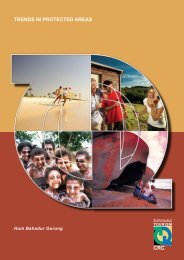icolls - Sustainable Tourism CRC
icolls - Sustainable Tourism CRC
icolls - Sustainable Tourism CRC
You also want an ePaper? Increase the reach of your titles
YUMPU automatically turns print PDFs into web optimized ePapers that Google loves.
ECOLOGY, THREATS AND MANAGEMENT OPTIONS FOR SMALL ESTUARIES AND ICOLLS<br />
30<br />
30<br />
25<br />
20<br />
15<br />
10<br />
5<br />
0<br />
-5<br />
Riparian<br />
Vegetation<br />
Tallows<br />
Belongil<br />
FPOM<br />
CPOM<br />
Epilithon<br />
Filamentous<br />
Algae<br />
Figure 4: Mean (± SE) δ 15 N signatures of all food web components collected from both Tallows and<br />
Belongil Creeks in May 2003<br />
The primary producers in Tallows and Belongil Creeks had δ13C signatures that spanned a wide range of<br />
values (Figure 5), facilitating our analyses of the percent contribution of the major food resources to consumer<br />
diets (using the IsoSource Mixing Model). In both systems, benthic algae were consistently 13C-enriched<br />
relative to other primary food sources (Table 6). However, benthic algal δ13C signatures ranged from -17 to -26<br />
‰, reflecting both the spatial variability of algal sources as well as the variety of algal types in these systems.<br />
For example, epilithon collected from the sediment tended had δ13C values ranging from –22‰ to –27‰,<br />
whereas filamentous algae collected from large woody debris (LWD) and/or cobbles ranged from –16‰ to –<br />
20‰ (Figure 5).<br />
Sources of riparian vegetation had depleted δ 13 C signatures relative to other primary sources, with values<br />
consistently around -29‰. BCPOM isotope signatures reflected a high contribution of these riparian sources,<br />
with very similar δ 13 C values.<br />
Food web structure differed substantially between Tallows and Belongil Creeks, although most consumers<br />
spanned the range of δ13C signatures of algal resources (filamentous green algae and epilithon) (Figure 5).<br />
IsoSource analyses of stable carbon and nitrogen isotope data revealed that despite differences in community<br />
composition and δ 15 N values, these sources of algal carbon fuelled both the Tallows Creek and Belongil Creek<br />
food webs (Table 6 Mixing Model Results). This finding is supported by the documented high productivity of<br />
both of these systems and reflects the value of within-system production in sustaining fish communities.<br />
Intraspecific Variation in δ 15 n Signatures in Tallows Creek<br />
Seston<br />
Mangrove<br />
Examination of fish isotope signatures in Tallows Creek revealed that some individuals of certain taxa were less<br />
enriched in δ 15 N than would be expected if they were long-term residents of this system (Figure 5). For example,<br />
mean δ 15 N isotope signatures of Ambassis marianus and M. cephalus were considerably depleted relative to the<br />
other fish taxa sampled. These lower mean δ 15 N values were due the presence of fish with δ 15 N-depleted<br />
signatures. We propose that these fish with comparatively depleted δ 15 N signatures are likely to be new recruits<br />
that had only recently entered the Tallows Creek system following the artificial opening event. Significantly,<br />
these new recruits had isotope signatures more typical of Belongil Creek than Tallows Creek, indicating that they<br />
had been recruited from a comparatively pristine system (Figure 5).<br />
Nereidae<br />
Bivalves<br />
Metapenaeus<br />
bennettae<br />
Gerres<br />
subfasciatus<br />
Ambassis<br />
marianus<br />
Rhabdosargus<br />
sarba<br />
Sillago ciliata<br />
Mugil<br />
cephalus











